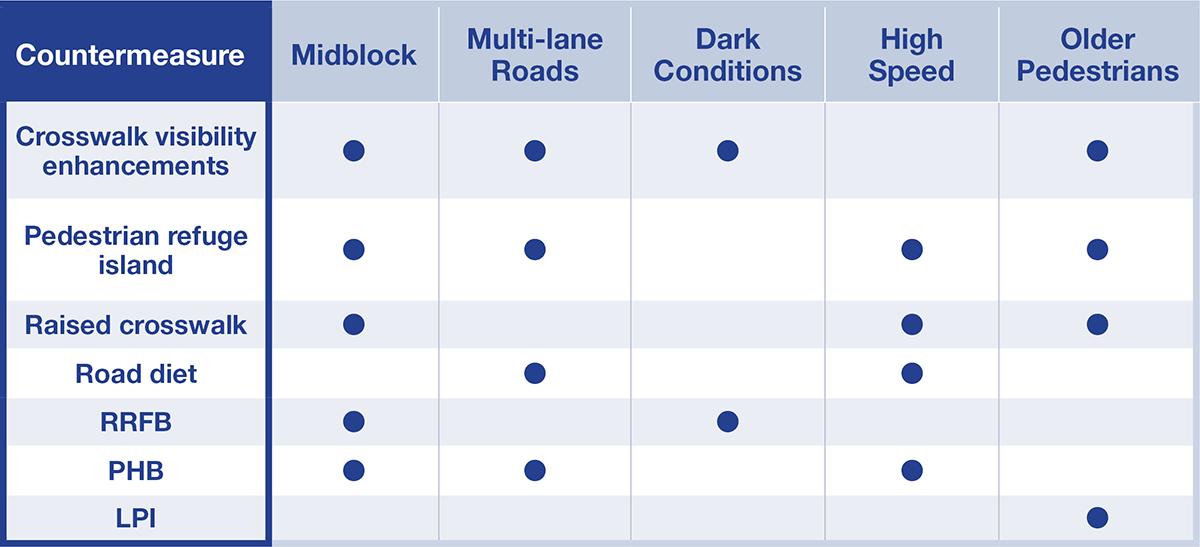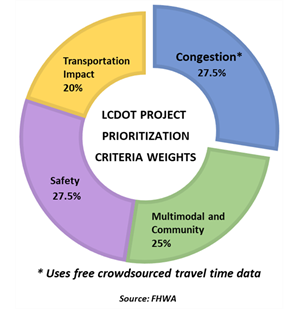May 6, 2021
Innovation of the Month:
Safe Transportation for Every Pedestrian
States are using resources from FHWA's Safe Transportation for Every Pedestrian Program to determine the best locations to implement countermeasures. Each of the "Spectacular Seven" countermeasures, crosswalk visibility enhancements, Leading Pedestrian Interval (LPI), Pedestrian Hybrid Beacons (PHBs), pedestrian refuge islands, raised crosswalks, Rectangular Rapid Flashing Beacons (RRFBs), and Road Diets, are most effective when placed at locations that meet certain criteria. Understanding this context is an important part of countermeasure selection.
PHBs are most often considered for multi-lane roadways with higher speeds. These beacons are effective countermeasures for midblock crossings and intersections that are distanced from signalized intersections. Results have shown PHBs are especially beneficial in areas with high volumes of pedestrian crossings and vehicles speeds, but traffic signal warrants are not met. North Carolina evaluated the effects of a PHB installed at an intersection in a beach town and found vehicle compliance at the crosswalk increased from 27 percent to 74 percent after the PHB was installed.
Another example includes pedestrian refuge islands. Refuge islands supplemented with a marked high-visibility crosswalk can be installed at intersections or midblock crossings; however, other design factors such as large vehicle traffic and narrow lane width should be considered for each location. Agencies considering a countermeasure for midblock crossings on roads with four or more travel lanes and higher speeds should consider a refuge island.
The table below also highlights how each of the spectacular seven countermeasures are beneficial for the five safety issues highlighted in STEP: midblock, multi-lane, dark conditions, high speed, or older pedestrian crossings.

To learn more about the "Spectacular Seven" countermeasures and where they should be used, read the series of tech sheets and case studies produced by the STEP team. If you would like to learn how your agency can improve pedestrian safety with STEP, contact Becky Crowe with FHWA's Office of Safety or Peter Eun with the FHWA Resource Center.
Free Crowdsourced Data Offers Value in Project Prioritization

The Lake County Division of Transportation (LCDOT) in Illinois has been archiving travel time data every two minutes for 600 directional road segments from a free navigation app provider. Beyond using this data in real-time for traveler information and incident management, LCDOT found this data valuable as a selection criterion in prioritizing their capital investment projects. Using this data, traffic engineers can better balance the congestion score, reflecting both intersection and route levels of service.
Crowdsourced data helps LCDOT deliver the best possible transportation system for residents and local commerce. To learn more about using crowdsourcing for project prioritization, contact James Colyar, Greg Jones, or Ralph Volpe, the FHWA EDC-6 Crowdsourcing co-leads.
States Reach 98% of Their Goals – EDC-5 Report
From 2019-2020, FHWA promoted 10 innovations that helped States shorted project delivery, enhance safety, reduce congestion, and integrate automation. In this cycle, collectively States achieved 98% of their goals to reach demonstration, assessment or institutionalized implementation. That is the highest implementation attainment since the program began in 2009. In the EDC-5 Final Report, learn more about the 10 featured innovations, see which innovations your State implemented over the last two years, and read spotlight features from around the country highlighting agencies that successfully used each innovation in their programs.
Will You Build a Better Mousetrap?
The FHWA Local Aid Support office is taking nominations for Build a Better Mousetrap (BABM) 2021 until June 11, 2021.
BABM celebrates innovative solutions for challenges that local and tribal transportation workers encounter. These innovations can range from the development of tools and equipment modifications to the implementation of new processes that increase safety, reduce cost, and improve efficiency of our transportation system.
Read the BABM Planning Guide to learn more about the entry categories, how to participate, and the selection criteria. To learn more about BABM 2021, contact your local technical assistance program (LTAP).
Discover Home-Grown Innovations from Around the Country

Are you interested in homegrown innovations being used by your peers in other parts of the country? Check out the National STIC Network Showcase, a component of the EDC-6 Virtual Summit. Over 200 innovations, submitted by State DOTs, Local Agencies, and other STIC members, are grouped into eight topic area categories for easy navigation. This site features a convenient one-time registration that will allow you to continue accessing information throughout 2021.
The showcase prominently features several innovations focused on pedestrian planning. Learn about the Florida DOT Safe & Accessible Pedestrian Inventory Model (SAPFIM), a low or no-cost web-based geospatial tool for data collection, assessment, mapping, and programming of pedestrian facilities needing Americans with Disabilities Act (ADA) or safety improvements; Illinois DOT ADA Sidewalk Templates, which use automated spreadsheet templates to aid in ADA sidewalk ramp design, reducing time and design iterations; and the Michigan DOT Gateway Treatment for Pedestrian Crossings, an inexpensive signing strategy which saw driver yield rates for pedestrians increase from less than 10 percent to greater than 90 percent, and drivers reduce speed by an average of five miles per hour at crossings.
Celebrate the ingenuity of your peers and read about these innovations—developed and deployed in-house at transportation agencies nationwide. Additionally, we invite you to watch the one-hour presentations on-demand that feature many of these and other innovations.

New Innovator Now Available!
The May/June issue of Innovator is now available, accessible from your computer, tablet, or mobile phone to optimize your reading experience!
In this issue:
- Collecting Public Feedback in Creative Ways
- STEP Up to Help Pedestrians Cross the Road Safely
- Implementing CHANGE in Vermont
- EDC Legacy: Uniting Around Common Goals
- And more…
Comments? Questions? We'd love your feedback! Drop us a line and let us know what you think.
Read past issues and sign up to receive Innovator by email here, or text "FHWA Innovation" to 468311 to get Innovator on your smartphone.
About EDC
Every Day Counts, a State-based program of the Federal Highway Administration’s Center for Accelerating Innovation, works with State, local, and private sector partners to encourage the adoption of proven technologies and innovations to shorten and enhance project delivery.





